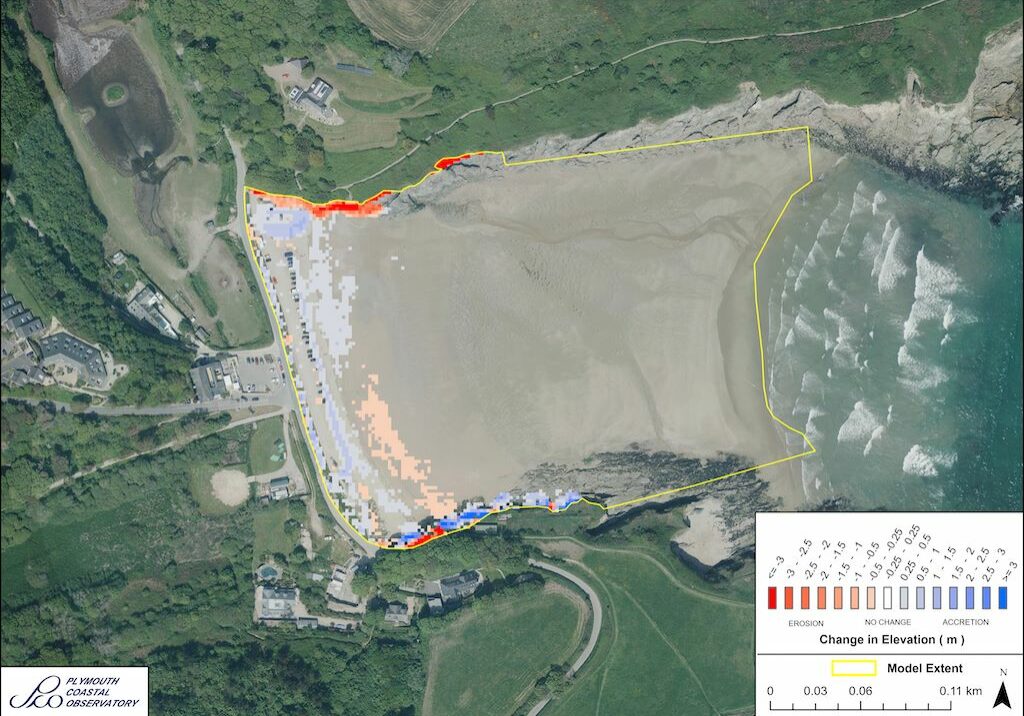
Maenporth (Cornish: Meynporth or Porth Meyn, meaning ‘cove of stones’) is a narrow east facing beach, within Falmouth Bay, on the south coast of Cornwall. Two watercourses flow onto the beach through two steep sided wooded valleys. To the south-west flows a small stream and to the north-west the Maenporth Stream after first flowing through, and filling, a series of lakes and ponds.
Maenporth is a gently shelving deeply incised sandy cove, fringed by steep sided cliffs to the north of Newporth Head and to the south of High Cliff. The site is considered more rural in nature, however, the uppershore of the location has been developed with a carpark and café to accommodate tourism demands. The uppershore boundary between the natural and built environment leaves little space for the coastline to rollback, making some parts of Maenporth more vulnerable to storm surges and more sensitive to sea level rise.


Coastal Change
The coastline of Cornwall is an ever-changing environment. It is energetic, dynamic, never still and changes with each wave and each tidal cycle. Some of the changes we see are gradual and barely noticeable, whilst others, such as rockfalls, happen suddenly and often shockingly.
From one visit to the next it can sometimes be difficult to see how a beach and dune system has changed, but information has been collected, and is being collected through the Making Space for Sand project, to help us better understand how the coastline is changing. The purpose of this section of the website is to understand each location has changed over time, how it could change in the future and understand the policies that influence how we can respond to these changes.
Shoreline Management Plans (SMP)
The Shoreline Management Plan (SMP) is a strategic planning and management assessment tool that helps identify and measure the risk associated coastal erosion and coastal flooding. The document makes a number of policy recommendations over short, medium and long term timeframes setting out a strategic approach to managing the built, natural and historic environments associated with the coastline. Within SMP there are four policy approaches which have been assigned to stretches of coastlines. The four policies are: No Active Intervention (NAI), Hold the Line (HTL), Managed realignment (MR), and Advance the line (ATL).
Maenporth sits within Policy Development Zone 5 (PDZ5), in Management Area 13 (MA13), within Policy Units (PU) 13.1 and 13.4. The policy recommendations for these policy units are detailed in the table below and the SMP can be accessed through the Cornwall Council website.
Use your touchscreen
to scroll the below table
| Policy Unit | SMP2 Policy Plan | ||||
| 2025 | 2055 | 2105 | Comment | ||
| 13.1 | Undefended cliff sections
Main Policy Sub Policy
|
NAI DnD |
NAI DnD |
NAI DnD |
Allow natural coastal evolution to occur to support conservation interest of protected sites of the Fal and Helford Special Area of Conservation. |
| 13.4 | Maenporth
Main Policy Sub Policy
|
HTL RnR |
MR P |
MR P |
HTL in the short term should provide scope to assess in more detail the implications of a managed realignment approach. |
| Key Main Policy: HTL - Hold the Line, A - Advance the Line, NAI – No Active Intervention MR – Managed Realignment
Sub Policy: DnD Do not Defenc, RNR – Repair not Replace, P - Placeholder |
|||||


National Coastal Erosion Risk Mapping (NCERM)
National Coastal Erosion Risk Mapping (NCERM) provides a baseline of coastal erosion, for the coastline of England, over short, medium and long-term timeframes. The data is based on the natural and defence characteristics of the coastline and provides rates of erosion at differing levels of confidence to help better plan for worse case scenarios. The data provided is for guidance and does not estimate the absolute location of the future coastline.
The basic NCERM lines show erosion estimates for the Short Term (ST-20 years), Medium Term (MT-50 years) and Long Term (LT- 100 years). The data is further categorised by probability: 05 is 5% probability (a 1 in 20 chance of being exceeded) Red Shading, 50 is 50% probability of being exceeded (a 1 in 2 chance of being either exceeded or not exceeded) Orange Shading and 95 is 95% probability (a 19 in 20 chance of being exceeded) Yellow Shading. Click the link below to access the Cornwall Council NCERM Mapping site read the about section then click on layers.

Historical Images of Maenporth
Historical photographs provide a powerful insight into how the Cornish coastline has changed within the past Century. The Making Space for Sand project are working in collaboration with the Francis Frith collection and have been given permission to share historical images on a number of beaches considered within the project.
In looking back, we can better understand how the coastline has changed, helping us understand not only how the coastal fringe has developed but also the potential future changes that we my observe. When this is considered alongside forecasts of coastal erosion and sea level rise it will help enable us to better adapt to our changing coastline.
Image of Maenporth beach from Newporth Cliffs in 1930 (Courtesy of the Francis frith collection) and in 2023.
Image of Maenporth beach from High Cliffs in 1907 (Courtesy of the Francis frith collection) and in 2023.
Image of Maenporth beach in c1960 (Courtesy of the Francis frith collection) and in 2023.

Modelling Coastal Change

Using data that has already been collected, combined with data collected through the Making Space for Sand project, a series of models will be carried out at each location. This will help us better understand how each location may respond to sea level rise and gain a deeper understanding of how coastal sediments move and behave.
The complexity of the modelling, and the data collection that helps inform it, means that modelling outputs will not be the same on all sites. Some locations will be more thoroughly investigated to understand more complex issues and provide data that can be more widely applied to other sites with similar characteristics.
As the project develops this section of the website will expand, sharing new reports and coastal change projections when they are produced.
LiDAR surveys, which are explained on the Data Modelling page, have been carried out by the South West Coastal Monitoring program at this location. The image shared here visualises where sand has eroded (areas shaded in red) and where it has built up (areas shaded in blue), between the LiDAR surveys carried out in 1998 and 2019. The darker the shade of red or blue the greater the amount of sand erosion or accumulation has been observed. The image helps visualise that beaches are areas that change shape over time and will continue to do so as sea levels rise.


Designations
The coastline represents an important transition between the marine environment and the terrestrial environment. This transition creates a range of special habitats and exposes a range of interesting features, which that can result in these spaces being highly designated and protected. There are a range of designations that recognise a variety of different features. At this location these designations are explored below.
Special Area of Conservation (SAC)
A Special Area of Conservation (SAC) is an internationally recognised designation with the aim of protecting habitats or species that are of European importance. Land with SACs is considered to be part of a network of high-quality conservation sites, and those considered to be most in need of conservation at a European level.
Image of grey seal basking in the sun (Courtesy of Susan Scott)
Fal and Helford SAC
The Fal and Helford SAC covers and area of approximately 6363 hectares. The sandbanks are biological rich and diverse with extensive areas of maerl (course shell) gravel. The sheltered estuaries associated with the SAC ae fringed with mudflats and sandflats that support rich and nationally important sediment communities. The rias (drowned river valley that remains open to the sea) of The Hel and Fal exposes the estuaries to the influence of the marine environment creating unique inlets and bays and narrow zonation between habitat types.
Image of anemone attached to seagrass (Courtesy of Susan Scott)
Designated Cornwall National Landscape Area
From November 2023, all areas previously know as Areas of Outstanding Natural Beauty, or AONBs, were re-named National Landscape and in Cornwall became Cornwall National Landscape. However, the Management Plan still references the term AONB as this was formally adopted by Cornwall Council and cannot be amended until the next plan is produced.
Cornwall National Landscape areas are protected landscapes whose distinctive character and natural beauty are so outstanding that it is in the nation’s interest to safeguard them. As such they have been nationally designated by the same legislation as National Parks and have the same status and level of protection.
The South Coast Western section covers an area of 19,258 hectares, which is 20% of the Cornwall National Landscape. The key characteristics of this coastal landscape is a soft profile. It benefits from the protection offered by the Penwith peninsula against the full force of the Atlantic storms.
Image of boast in Cadgwith Harbour (Courtesy of Sue Rowlands)
Special Protected Area (SPA)
A Special Protection Area (SPA) are areas of international importance for the breeding, feeding, wintering and migration of rare, threatened or vulnerable bird species.
The Falmouth Bay to St Austell Bay SPA covers the area of 258,98 hectares, below mean high water (MHW),between Nare Point and Gribben Head. The area qualifies for designation as it is regularly used by Annex I listed species including the Black-throated diver, the Great northern diver and the Slavonian grebe.
Image of birds resting on buoys in the Helford River (Courtesy of Susan Scott)
Sign up to Making Space for Sand
If you would like to get involved in helping to make dunes more resilient and biodiverse, want to help develop coastal adaptation and emergency plans or just want to know more about what the project is learning about coastal change, please click here:








